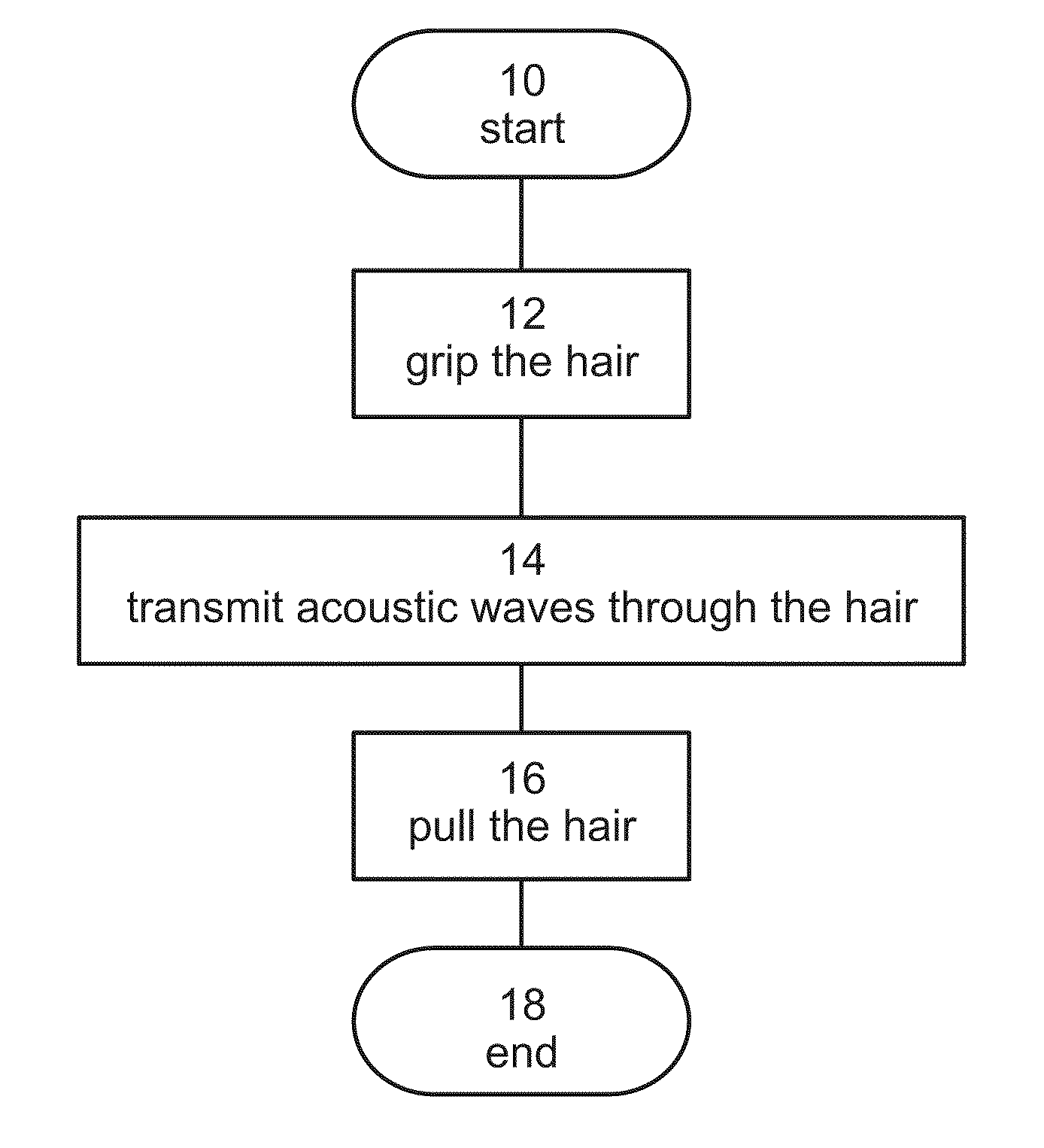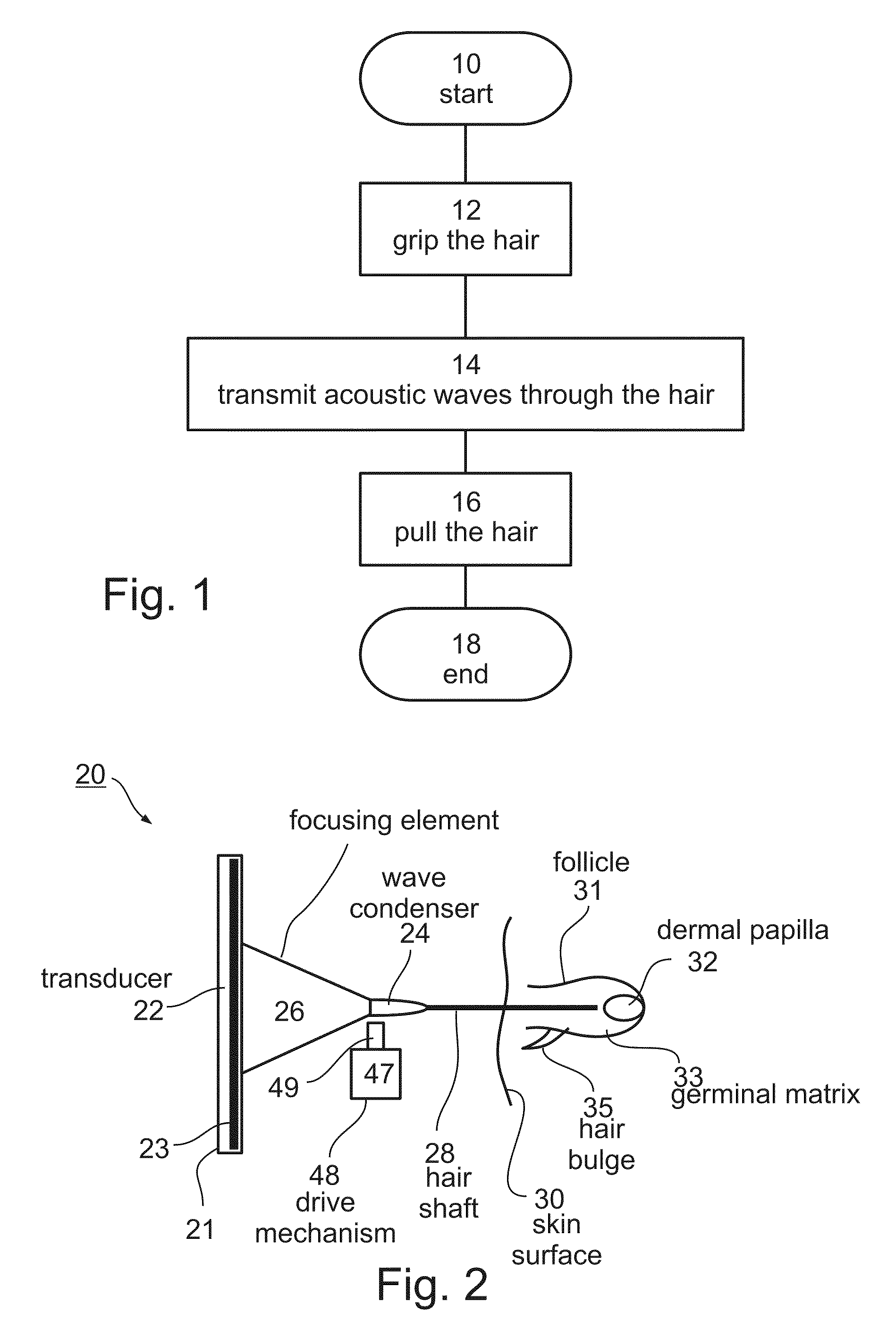Method and device for removing hair
a hair removal and hair technology, applied in the field of aesthetic care, can solve the problems of ineffective acoustic wave coupling, prior art failure to provide hair removal methods, and inability to teach how to effectively couple acoustic waves, so as to improve acoustic coupling and minimize the vibration of hair
- Summary
- Abstract
- Description
- Claims
- Application Information
AI Technical Summary
Benefits of technology
Problems solved by technology
Method used
Image
Examples
examples
[0167]Reference is now made to the following examples, which together with the above descriptions illustrate the invention in a non limiting fashion.
[0168]FIG. 8 is a schematic illustration of a simplified model of the geometry of the hair, which include three well distinguished regions: (i) the hair shaft above and below the skin surface, (ii) the hair bulb which comprises the dermal papilla and the germinal matrix, and (iii) the hair bulge, which is a part of the follicle and located near the hair shaft between the skin surface and the hair bulb. The hair shaft has a substantially smooth and extended structure and is located within the air, or the soft tissues which have distinctly different acoustic impedance. The hair shaft presents a good system for guiding an acoustic energy from the top end to the hair bulge and the entry point into the hair bulb.
[0169]The geometry of the hair bulb and hair bulge considerably differs from the geometry of the hair shaft. Mul...
experiment 1
[0177]A prototype wave condenser was built in accordance with a preferred embodiment of the present invention. The wave condenser was manufactured with a pore which was filled with ultrasound transmission gel. The diameter of the wave condenser was 8 mm and the dimensions of the pore were 1 mm in diameter and 5 mm in length.
[0178]A few human hair shafts were introduced into the condenser. An ultrasound transducer was assembled directly on the condenser, without intermediate focusing element. The ultrasound transducer was operated for about 0.1 second at a frequency of 1005 kHz and a power density of about 5.2 watts / cm2 on its surface.
[0179]FIG. 9 is an infrared image of the treated hair shafts. Also shown in FIG. 9 is an image of the wave condenser. As shown in FIG. 9, the acoustic waves successfully heated the hair shafts with the hot point at the distal end of the hair shaft acquiring a temperature of 142° C.
experiment 2
[0180]Four human hair shafts were introduced into the wave condenser of Experiment 1. For each hair shaft, a different coupling length h was defined by a different insertion depth of the hair shaft into the wave condenser. The following coupling lengths were examined, h=2 mm, h=4 mm, h=6 mm and h=8 mm. The ultrasound frequency was 817 kHz, and the power density at the surface of the ultrasound transducer was set at two values: a lower density of about 1.2 watts / cm2 and higher density of about 2.5 watts / cm2.
[0181]FIG. 10 is a graph showing the temperature of the hair shafts as a function of the coupling length. As shown in FIG. 10, a close to linear increment of the hair shaft temperature with h was observed. This result is in agreement with the above model, because larger values of the coupling length correspond to higher levels of wave penetration into the hair shaft thereby to larger ultrasound energy propagation within the hair shaft.
PUM
 Login to View More
Login to View More Abstract
Description
Claims
Application Information
 Login to View More
Login to View More - R&D
- Intellectual Property
- Life Sciences
- Materials
- Tech Scout
- Unparalleled Data Quality
- Higher Quality Content
- 60% Fewer Hallucinations
Browse by: Latest US Patents, China's latest patents, Technical Efficacy Thesaurus, Application Domain, Technology Topic, Popular Technical Reports.
© 2025 PatSnap. All rights reserved.Legal|Privacy policy|Modern Slavery Act Transparency Statement|Sitemap|About US| Contact US: help@patsnap.com



